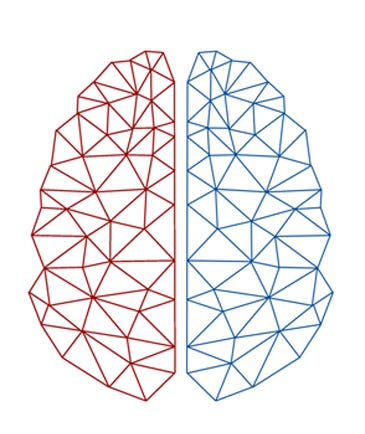Moral Operating Systems: How Swing Voter’s Brains Work
Democrats run on BlueOS. Republicans run on RedOS. Swing voters have two phones.
Our political attitudes are based on belief systems we develop in early childhood. Those belief systems make up our neural networks, our brain’s “moral operating systems.” Many people run on either a “Red” operating system or a “Blue” operating system. Swing voters have two phones: they can process messaging from both perspectives. Our job? Get them to use the blue phone. Get them to use the blue phone so much, that they leave the red phone home in a drawer.
Introduction
When I advise people about messaging, I tell them that we should never talk about Republicans or use their wording. Instead, we should only talk about what we believe, and describe every situation from our own perspective using our own wording.
This feels counter-intuitive, but it makes perfect sense once you learn a few key facts about how brains process language. Here is the relevant neuroscience adapted from George Lakoff’s work on framing and Theory of Moral Politics.
Thank you for reading Reframing America! This is a reader-supported publication. To receive new posts by email please consider becoming a subscriber. All content is free, but some people choose to become paying subscribers to support this mission!
What is a Moral Operating System?
All political perspectives are based on the sense of right and wrong that lies at the very core of our identity.
Everybody has a belief system, an internal construction of how the world works. It consists of our attitudes toward the world and the people in it, where we fit in, and how we are supposed to interact with it. It includes what we believe is true or real, what we believe is important and what we believe is morally right and wrong (our values).
Think of these as our moral “operating systems.” They physically exist in our brains’ neural networks. We grew them in the first five years of childhood, based on what we experienced and were taught growing up.
RedOS versus BlueOS
Why do Americans have “red” or “blue” operating systems?
In our society, children raised in conservative families and liberal/progressive families experienced and were taught very different things growing up, so we developed different belief systems with conflicting ideas about how the world works, what is real or true and what is right or wrong.
These competing moral operating systems are the raw material from which we form our political beliefs.
For example:
Being raised to fear and distrust people who aren’t like you leads to anti-immigrant political beliefs, while being raised to learn about and welcome people who are different from you leads to pro-immigration political beliefs.
Being raised in a family where “Father always knows best” leads to political beliefs in which “men making decisions for women” is seen as care and protection, while being raised in a family with parents who treat each other as equals leads to political beliefs in which “men making decisions for women” is seen as oppressive.
In the United States, these belief systems correspond very strongly with our two political parties, Republican and Democratic, so let’s call them “RedOS” and “BlueOS.”
What are the two moral operating systems?
In his books Moral Politics, the best-selling Don’t Think of an Elephant: Know your values and frame the debate and others, George Lakoff shows how these competing worldviews are defined by two parenting models, the “Nurturing Parents” model and the “Strong Father” model, and how aspects of those models correspond with, and explain a great deal about, specific political beliefs later in life.
I also talk about the competing values in these two systems in previous issues of this newsletter, such as What Democrats are FOR: Our Values and Big Themes and Elevator Speeches.
Who is persuadable and why?
You can’t run a BlueOS app on a RedOS phone.
Some people have just the one operating system. There’s no point in arguing with diehards on either side. It’s not that they don’t want to understand the others’ positions. Some actually can’t. They physically lack the neural networks to process it.
So, whose political attitudes and choices can we influence?
Persuadable people have two phones.
A persuadable voter is someone who is capable of processing the messaging from both sides. Some people were raised with exposure to both moral models. Maybe they had a liberal Mom and a conservative Dad. These people have two phones: a RedOS phone and a BlueOS phone. Like a work phone and a personal phone, they use them at different times and for different reasons.
The political debate is a fight between Democrats and Republicans over which phone persuadable people are going to use, because which moral operating system they use determines how they judge right and wrong in the public debate.
How do we persuade people?
Frames of Reference
Inside our operating system, we have millions of frames. Frames are like apps that run on our neural operating systems. A frame is the network of neurons that holds everything you know or have ever experienced about a particular topic. We have frames for everything: Baseball. Freedom. Italian restaurants. Bullies. Plastic food storage containers. Joy. Math. If we can think about it, we have a frame for it.
Our brains process input by giving it a frame of reference. When we hear the word “strike” we can either think of it in terms of labor organizing or in terms of baseball. It depends on which frame we use.
Words and phrases act as triggers that activate the neural network for a particular frame. It’s like using verbal commands to make your phone open and run a particular app:
If you say, “AFL-CIO,” it’s like saying, “Hey Siri, open the Union app and process ‘strike’ in terms of labor organizing.”
If you say, “Go Cubbies,” it’s like saying, “Hey Alexa, open Baseball and use it to think of ‘strike’ from the perspective of baseball.”
Every time we communicate with people, we expose them to trigger words and phrases. We give their neural operating systems verbal commands that make them run apps. The process is subconscious, automatic and involuntary.
Framing the Debate with Verbal Commands
We make people use their Democratic values (moral operating system) by using the verbal commands (triggers) that open the apps (frames) that only run on BlueOS. Republicans do the same, only for RedOS apps.
For example:
Verbal commands like “unborn child” or “partial-birth abortion” say, “Hey Voter, open and run the Fetal Personhood app and process this debate from the perspective of the rights of the fetus.”
Verbal commands like “state-mandated pregnancy,” “involuntary medical servitude” or “using people’s bodies against their will” say, “Hey Voter, open Bodily Autonomy and use it to process this debate from the perspective of women’s right to physical self-determination.”
Verbal commands like “grooming,” “woke” or “CRT” say, “Hey Voter, open Parent’s Rights and process this debate from the perspective of protecting children (from non-existent threats.)
Verbal commands like “book banning,” “censorship” or “teacher surveillance” say, “Hey Voter, open Creeping Fascism and process this debate in terms of abuse of power and threats to freedom.
The Bottom Line
We must ONLY use Democratic verbal commands and NEVER use Republican verbal commands.
When we talk about Republicans or respond to what they are saying about us, we use their verbal commands, unintentionally triggering persuadable people to see things from the Republican point of view.
If we talk about what we believe and describe everything from our own perspective, using our own verbal commands, we trigger persuadable people to see things from the Democratic point of view.
Republicans direct a massive amount of resources and effort toward figuring out which frame they want people to use to process each political issue, and which words will function as the best triggers/verbal commands to make people see it from that perspective.
If we expect to beat them in the public debate, we have to work just as hard to define our own perspectives and identify and use our own “verbal commands.”
Thanks, as always, for reading and subscribing! I hope you are able to use this in your work and your activism!
In solidarity,
Antonia
Thank you for reading Reframing America! This is a reader-supported publication. To receive new posts by email please consider becoming a subscriber. All content is free, but some people choose to become paying subscribers to support this important mission!








Keep these articles coming, please. I've read George Lakoff and agree with most of his findings and viewpoints, but I'm finding implementing his recommendations is a lot harder than understanding his concepts. It would be nice if there were some videos showing role plays of wrong way/right way to have a discussion about progressive beliefs, but thus far I haven't seen anything like that. Reframing America is the stepping stone between theory and practice, so, please, keep publishing!
Antonia: Every word on this is precious. Kudos to you! Love the op systems' analogy!